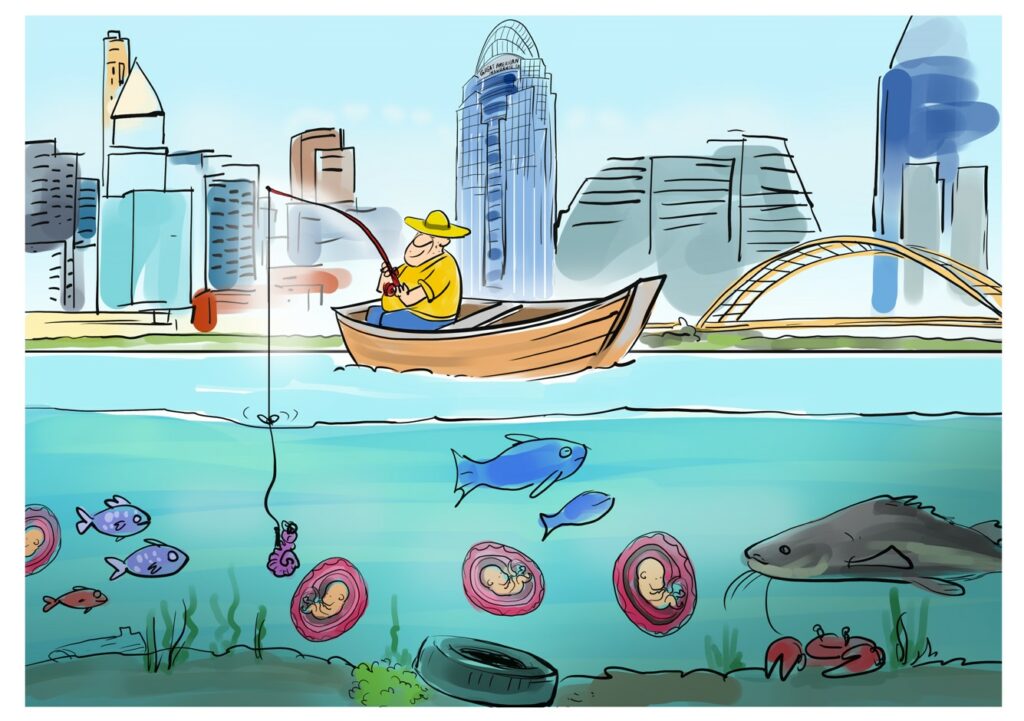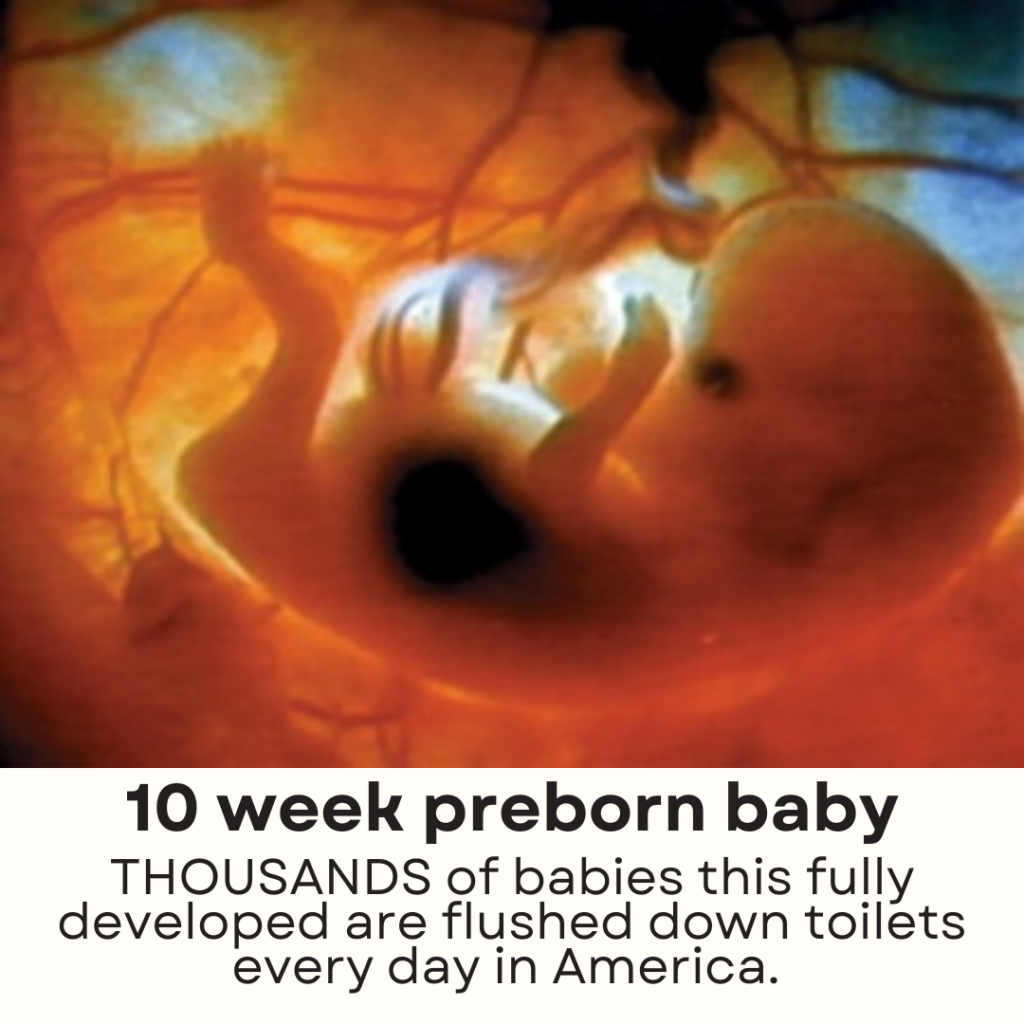
If you live in Cincinnati, are you drinking fetal remains?
Abortion at all Costs?
How the chemical abortion industry has propelled the U.S. to a top-three abortion nation globally while simultaneously threatening our water systems with aborted fetuses and highly toxic chemicals.
By: Lisa Murtha
Chances are, if you were born in the 1970’s or 80’s, the words “safe, legal and rare” were indelibly burned on your brain in connection with abortion procedures. Those three words were first uttered by former President Bill Clinton, who greatly increased national access to the procedure and paved the way in the early 1990’s for chemical abortion to be introduced to U.S. women.
That said, I was taken aback recently to read on Wikipedia that our country is now in the top three globally for cumulative number of total abortions performed in its history, with somewhere between 62 and 70 million total, behind only India, with 100 million total, and China, with 336 million total. In addition, the Wikipedia article noted, “Some analysts have estimated that up to two million abortions occur [in the U.S.] annually,” which, if true, would place the U.S. in the top five globally for annual number of abortions performed, tied with Nigeria and Pakistan and, again, behind only India and China.
These are fascinating statistics for us to have achieved, given that our peers in annual abortion numbers are two developing countries, the most polluted nation in the world and communist China (which is also a major contributor to global environmental concerns).
Here in the U.S., the rise in numbers of fetal deaths can be directly attributed to the rise of chemical abortion. Even Wikipedia notes that all the estimated numbers of abortions per country on its current site “do not account for medical abortions outside a clinic” (in other words – chemical abortions, which are done almost exclusively in the privacy of one’s own home).
This is interesting, given that media outlets have claimed since 2022 that the Supreme Court overturning Roe v. Wade would remove significant access to abortion in the U.S; a quick look at the facts shows that the opposite is actually true. Earlier this year, in fact, CNN.com reported on a Guttmacher Institute report showing U.S. abortions have actually increased since the fall of Roe v. Wade, and instead reached their “highest level in over a decade, sparked by surge in medication abortion.
“Nearly two-thirds of all abortions in the US in 2023 – an estimated 642,700,” the article goes on to say, “were medication abortions” – an “option [that] has become steadily more common over the two decades it’s been available, rising from less than 10% of all abortions in the US in 2001 to 53% in 2020 and 63% in 2023.”
NPR.org also covered the same Guttmacher report, and quoted obstetrician, gynecologist and Baylor University medical school professor Dr. Anitra Beasley as saying that she believes “the true number is even higher than what was measured in the report,” or “an undercount,” because it does not include women who get abortion pills from friends or “over-the-counter at a pharmacy in Mexico, for example.”
Whether Americans believe abortions destroy early-stage human beings or “the products of conception” (which is how medical literature currently describes premature fetuses), one issue that has received scant media coverage as chemical abortion has grown is what happens to the medical waste resulting from such procedures.
The current guidelines for chemical abortion include prescribing two pills designed to induce abortion – mifepristone, to suppress production of the pregnancy-maintaining hormone progesterone; and misoprostol, or prostaglandin, to induce contractions and expel a child from the uterus – and having women up to 10 weeks pregnant take the drugs at home (though some women as far along as 12 weeks have been given the drugs as well). What comes next, however, is the stuff of horror movies; the current unwritten, but very real guidelines for those taking abortive drugs, is to flush the poison-soaked aborted child and all of the mother’s blood and tissue down the toilet and into the wastewater system.

Nevermind the colossal ethical dilemma of flushing human remains down a toilet, especially in a wastewater system that is not built to process human remains and often recycles wastewater into drinking water. The second major elephant in the room is whether this suggestion of flushing medical waste down a toilet – hundreds of thousands of tiny, yet entire, human bodies each year – is legal.
Turns out, there are laws in every state regarding how medical waste must be disposed of. There are also laws in many states dictating how aborted infants must be disposed of as well. In Ohio, for example, Chapter 3726 of the Ohio Revised Code states explicitly that fetal remains from abortions must be buried or cremated, and that those who do not comply are “guilty of failure to dispose of fetal remains humanely, a misdemeanor of the first degree.” The Ohio EPA also has strict guidelines on the disposal of hazardous and infectious waste materials, both of which a blood- and poison-soaked fetus could unfortunately be; nowhere does the state EPA advocate for flushing either of these down a toilet into the wastewater system.
In fact, common sense and history would say that flushing human remains by the hundreds of thousands each year is likely unsafe, given that our nation’s wastewater supply is increasingly closely linked to our drinking water supply. This is especially true in densely populated U.S. urban areas, per this University of Tennessee report, which notes not only that “civilization will have to adapt to the notion of there being a direct connection between the wastewater treatment plant and the water treatment plant,” but also that “you are [already] consuming recycled water.”
Consider also that diseases like cholera have a strong history of spreading rapidly in places where drinking water is unclean. As recently as 2022, in fact, Euronews.com reported that, “In India… many covid victims were buried in shallow mass graves close to the River Ganges, with many of the bodies re-emerging after seasonal flooding. This raised health concerns among local populations, as diseases such as cholera can spread into waterways if bodies are not adequately buried.”

In some states it is legal to dissolve deceased human bodies through a process called “alkaline Hydrosis,” which essentially uses water to break down a body into bones and organic compounds, the latter of which is then reintroduced into the wastewater supply, where it is treated and eventually potentially joined back into drinking water supplies, depending on where you live. But it is crucial to note that chemically aborted babies are not being afforded even the dignity, slight as it is, of alkaline hydrosis. They are instead being directly flushed into our nation’s sewer system, as is, by the hundreds of thousands and left to decompose – toxic chemicals and all – on their own, not unlike the bloated and bacteria-ridden dead bodies that find their way into rivers in India.
Which brings up another point. It’s also highly likely the chemical abortion drugs themselves are, like all pharmaceuticals, not really broken down by human bodies and are therefore largely present in both the urine and tissues of post-abortive mothers, as well as the tissue and blood of chemically aborted infants. In other words, the mifepristone and misoprostol, too, are almost certainly contaminating our water supply as well.
Though compromised organizations like the World Health Organization, or W.H.O. (historically funded in large part by the Bill and Melinda Gates Foundation, which is also a major financial backer of pharmaceutical research and distribution worldwide), claim emphatically that there is no danger, in actuality, they do quietly admit that: no one has any idea how many drugs can even be removed from wastewater (“These processes have demonstrated varying removal rates for pharmaceuticals, ranging from less than 20% to greater than 90%.”); “There are few comprehensive, systematic studies on the occurrence of pharmaceuticals in drinking-water;” and “Most countries do not have monitoring programmes to routinely test for pharmaceuticals in drinking-water.” Laughably, the organization also blamed “advances in analytical techniques and instrumentation” for a 2012 increase in detected prescription drugs in global water supplies.
Since then, documented evidence of dangerous pharmaceutical levels in U.S. water has grown prevalent. Consider this 2018 Pharmaceuticals in Water report produced by the United States Geological Survey (USGS), which definitively notes that “Pharmaceuticals get into the water supply via human excretion and by drugs being flushed down the toilet. You might think wastewater treatment plants would take care of the situation,” the report goes on to say, “but pharmaceuticals pass through water treatment.”
Also consider a 2013 USGS report that revealed researchers had discovered legitimately intersex wild fish – biological males that were also producing eggs – in the Potomac River. The culprit? High levels of synthetic estrogen from birth control pills that made its way into fresh waterways.
And even the W.H.O. itself, again, buried deep in its own 2012 report, admits that “Scientists demonstrated the presence of pharmaceuticals in the environment more than 30 years ago, with studies in the United States of America (USA) in the 1970s that reported the presence of heart medications, pain relievers and birth control medications in wastewater. The most cited reference in the peer-reviewed literature on the occurrence of pharmaceuticals in surface waters,” the W.H.O. goes on to say, “is the survey by the United States Geological Survey, in which more than 50 pharmaceuticals in 139 streams across 30 states in the USA were investigated during 1999 and 2000.”
The same report notes that “Many peer-reviewed and published studies have shown that the primary sources of pharmaceuticals entering surface water are from excretion and bathing through treated or untreated municipal wastewater effluent discharges into receiving surface water bodies … and improper disposal of pharmaceutical waste and excess medication by consumers and health-care and veterinary facilities into sewers and drains.”
Pause and fast forward now to 2024.
Is it possible that hundreds of thousands of decomposing, poison-filled infant bodies might be equally as dangerous to our water supply, if not moreso, as generic “pharmaceutical waste” and “excess medications?”
Bringing the discussion back to abortion pharmaceuticals specifically, it’s crucial to note that not only have the drugs not been studied for their longevity or even existence in wastewater, they have not been studied for their effects on humans long term at all. Researchers have only, in fact, studied chemical abortion’s effects on newborn rats, noting ominously that “oviduct and ovary malformations in female rats, delayed male puberty, deficient male sexual behavior, reduced testicular size, and lowered ejaculation frequency were noted after exposure to mifepristone” in this very tiny population.
In other words, like the synthetic estrogen in water supplies, mifepristone as passed through a mother’s blood to her baby has a proven ability to feminize male living beings and significantly alter the female reproductive system. Note that the researchers do not specify how often these abnormalities were “noted,” which means they could have happened in every baby rat, or only rarely – we have no idea which one is closer to the truth.
Despite all of this evidence, the most hardened abortion supporters seem to elevate the chemical abortion procedure over environmental concerns when it comes to discussing dumping poison-filled fetal remains into the nation’s wastewater systems. Consider this Politico article by an Oberlin College grad, which quotes a female attorney/pro-abortion activist saying that pro-lifers are essentially “co-opt[ing] the environmental movement for their own agenda.”
The article ironically (and begrudgingly) does provide a silver lining of hope for those actually concerned about both inhumane infant disposal methods and the earth’s environment. The Politico piece notes that a pro-life group called Students for Life is both petitioning the U.S. government to require doctors to treat aborted fetuses as medical waste and “working on bills” alongside GOP politicians to “require any doctor who prescribes [abortion] pills to be responsible for disposing of the fetal tissue” by bagging and treating it “as medical waste, rather than flush[ing] it down the toilet and into the wastewater.”
Students for Life of America President Kristan Hawkins perhaps summarizes the organization’s position best. “It’s painfully ironic,” she wrote in a February letter to the U.S. EPA, “that the Biden Administration’s environmental zealots will make gas stoves and functioning cars a thing of the past while demanding government-sanctioned, corporate dumping of aborted human children and pathological waste. The Pro-Life Generation is calling on the EPA to track the active metabolites in the pollution from Chemical Abortion Pills that today are flushed into our drinking water. The EPA must do its job and add the elements of Chemical Abortion Pills to its ‘forever chemicals’ monitoring. Everyone needs safe drinking water.”
Lisa Murtha is an Award-Winning Journalist for Print and Visual Media, and the 2023 National Society of Newspaper Columnists Finalist
